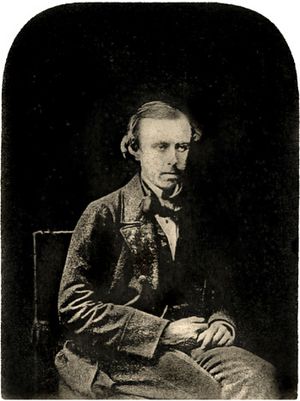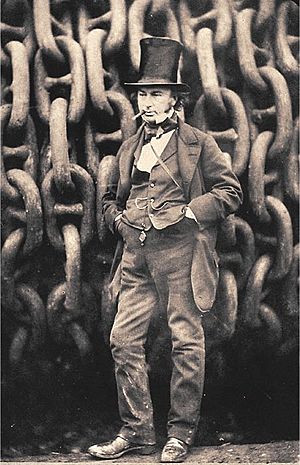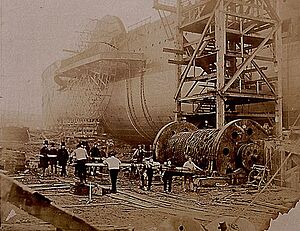Robert Howlett facts for kids
Quick facts for kids
Robert Howlett
|
|
|---|---|
 |
|
| Born | 3 July 1831 |
| Died | 2 December 1858 (aged 27) London, England
|
| Occupation | Photographer |
Robert Howlett (born July 3, 1831 – died December 2, 1858) was a very important early British photographer. His pictures are still shown in big art galleries today.
Howlett took photos of soldiers who were heroes from the Crimean War. He also captured scenes of everyday life and beautiful landscapes. His most famous picture is of Isambard Kingdom Brunel, a famous engineer. This photo was part of a job for a newspaper called Illustrated Times. The newspaper wanted to show how the world's biggest steamship, the SS Great Eastern, was being built.
Robert Howlett showed his photos at the London Photographic Society. He also wrote a book called On the Various Methods of Printing Photographic Pictures upon Paper, with Suggestions for Their Preservation. He worked with Joseph Cundall at a place called "The Photographic Institution" in New Bond Street, London.
Howlett also took special photos for the artist William Powell Frith. These pictures helped Frith paint his huge artwork called The Derby Day, which was shown in 1858.
Queen Victoria and Prince Albert asked Howlett to take photos of paintings at Buckingham Palace. He also made copies of famous paintings by Raphael. Another important job was taking portraits of 'Crimean Heroes', which were shown in 1857.
Sadly, Howlett died in 1858 when he was only 27 years old. He died from typhoid fever. The Illustrated Times newspaper praised him as "one of the most skillful photographers of the day." After he died, his partners continued to publish prints from his photographs.
| Top - 0-9 A B C D E F G H I J K L M N O P Q R S T U V W X Y Z |
Robert Howlett's Early Life

Robert Howlett was the second of four sons. His father was Reverend Robert Howlett. Robert was born in Theberton, a town in Suffolk, England. By the time he was nine, his family had moved to Longham in Norfolk.
His grandfather, Thomas Harsant, was a surgeon. He built cool things like telescopes and microscopes. Robert was very clever and built his own microscope when he was a child. When his grandfather died, Robert received some money and tools. This helped him move to London to start his career.
How Howlett Became a Photographer
In London, Robert Howlett became well-known while working for "The Photographic Institution." This was a top place for photography in London. It showed photos, published books, and took on special jobs.
The institution was started by Joseph Cundall and Philip Henry Delamotte. It's thought that Howlett took Delamotte's place. In December 1855, Howlett became a member of the Photographic Society of London. This group later became the Royal Photographic Society. He stayed a member until he died.
By 1856, people in the photography world were talking about Howlett. He sent his photos to art shows in London, Manchester, and Norwich. These included pictures of landscapes, like the Valley of the River Mole and Box Hill, Surrey.
He also wrote a small book in 1856 about how to print and keep photos. Howlett even designed and sold special 'dark room tents' for photographers.
Working for the Royal Family
Howlett started working for Queen Victoria and Prince Albert in 1856. He copied famous paintings by Raphael for Prince Albert. He also took many portraits of brave soldiers from the Crimean War. These photos were shown in 1857 as 'Crimean Heroes'.
In 2004, some of Howlett's photos of these war veterans were used on Royal Mail postage stamps. This was to mark 150 years since the Crimean War.
Howlett also took studio portraits of famous artists. These included William Powell Frith and John Callcott Horsley. These pictures were shown at a big art exhibition in Manchester in 1857.
He was also asked to take photos of the crowd at the 1856 Epsom Derby horse race. These photos helped the painter William Powell Frith create his famous painting The Derby Day. Howlett took these pictures from the roof of a taxi!
The Amazing Great Eastern Ship
One of Howlett's most important jobs was for The Illustrated Times Weekly Newspaper. They asked him to photograph the building of the SS Great Eastern. This was the biggest steamship in the world at that time.
Howlett's photos were turned into wood-engravings for the newspaper. They helped show how amazing this engineering project was.
This project included his very famous picture of Isambard Kingdom Brunel. Brunel was the engineer who created the Great Eastern. The photo shows him standing in front of the giant chains used to launch the ship. This picture was taken in November 1857 to celebrate the ship's launch.
This photo is special because it shows Brunel in an industrial setting, not a plain background. It's known as one of the first "environmental portraits." This means the background helps tell you about the person.
Robert Howlett's Death
Robert Howlett died in 1858 when he was 27 years old. He passed away at his home in London. This happened shortly after he came back from France, where he was trying out a new camera lens.
He died from typhoid fever. Some people at the time thought he died from chemicals used in photography. However, his death certificate simply said 'febris' (fever). The Illustrated Times newspaper called him "one of the most skillful photographers of the day."
Howlett's Grave
Robert Howlett is buried at a church in Wendling, Norfolk. His gravestone is behind the main part of the church.
In 2017, a campaign helped restore his grave. A special service was held to remember him on October 14, 2017.
Where to See Robert Howlett's Photos
You can see Robert Howlett's photographs in many famous art galleries around the world:
- London, National Portrait Gallery
- London, Victoria and Albert Museum
- New York, Hans P. Kraus, Jr., Fine Photographs
- San Francisco Museum of Modern Art
- Cleveland Museum of Art
Modern Tributes to Howlett
In 2008, a photojournalist named David White recreated Howlett's camera. He then traveled around England to take photos like Howlett did for the Brunel project.
In 2009, David White also published an article about Robert Howlett called The Light Shone and Was Spent: Robert Howlett and the Power of Photography.


